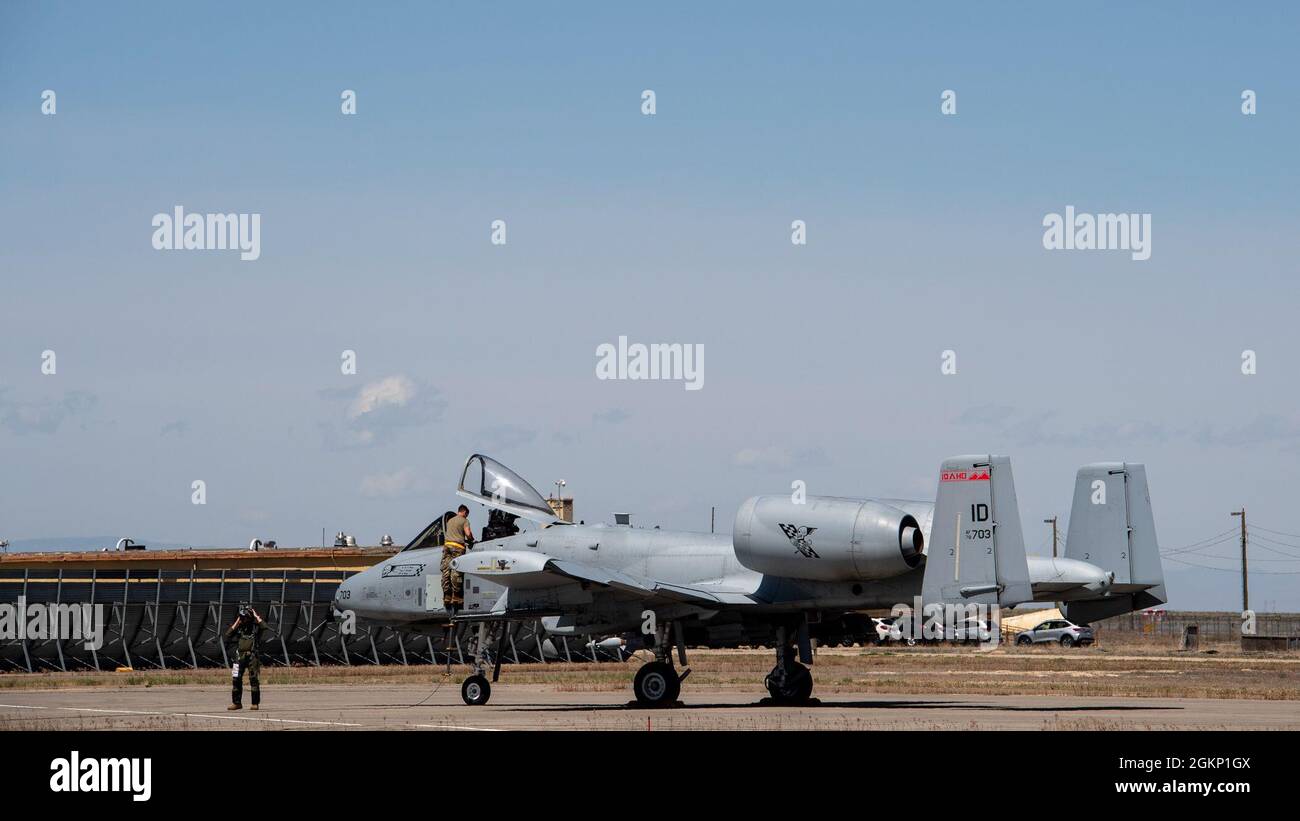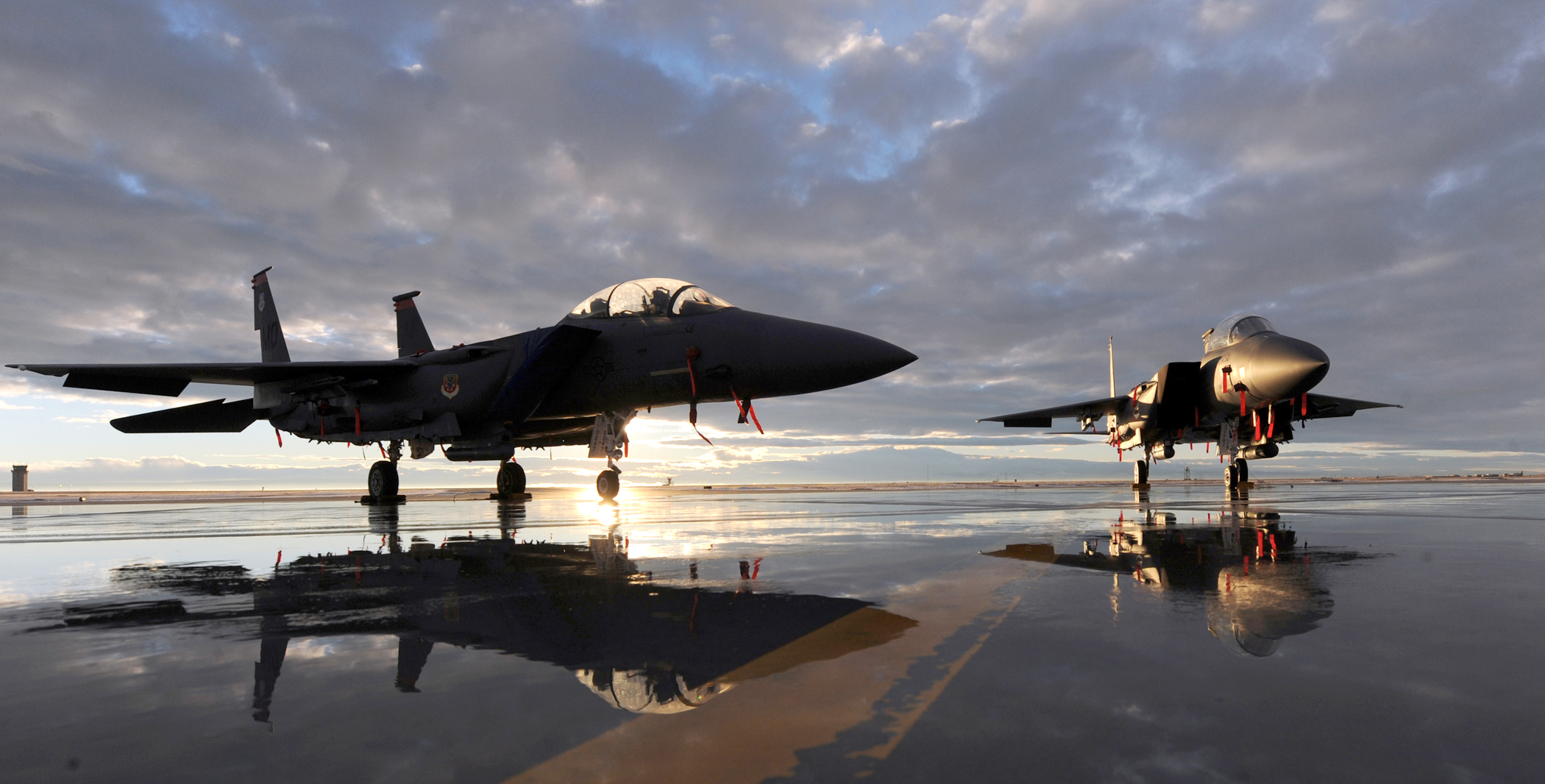Boise Air Force Base - 43 ° 02'N 115 ° 52'W / 43.04 ° N 115.87 ° W / 43.04; -115.87 Coordinates: 43 ° 02'N 115 ° 52'W / 43.04 ° N 115.87 ° W / 43.04; -115.87
Mountain Home Air Force Base (IATA: MUO, ICAO: KMUO, FAA LID: MUO) is a United States Air Force (USAF) installation in the western United States. Located in southwestern Idaho in Elmore County, the base is twelve miles (20 km) southwest of Mountain Home, forty miles (65 km) southeast of Boise via Interstate 84. The base is also used by the Republic of Singapore Air Force ( the RSAF), with a fleet of F-15SG fighter jets long assigned to the base and a fleet of RSAF and USAF personnel.
Boise Air Force Base

Since 1972 the military unit at Home Mountain has been the Air Combat Command's (ACC) 366th Fighter Wing (366 FW), nicknamed the "Gunfighters". The primary mission of the base is to provide combat air power and combat support power to respond and sustain operations worldwide.
Mountain Home Air Force Base Conducts Lead Wing Exercise
Built during World War II as a bomber training base in the early 1940s, it was briefly decommissioned after the war, serving as a bomb and missile base. It became a battlefield 57 years ago in 1966.
Workers began building the base in November 1942, and the new field was officially opened on August 7, 1943. Soon after, the Airum field began training US Army Air Force personnel in World War II. The 396th was the first unit assigned to the Bombardment Group (Heavy), and its planned mission was to train the crews of the B-17 Flying Fortress. However, before the first B-17s arrived, field plans changed and the 396th was sent to Moses Lake AAF, Washington.
Instead of training B-17 crews, Mountain Home Airum began training B-24 Liberator crews. The first unit to do so was the 470th Bombardment Group (Heavy), which trained at Mountain Home from May 1943 to January 1944, after which the unit moved to Tonopah AAF Nevada. The 490th Bombardment Group (Heavy) replaced the 470th and trained B-24 crews until it was transferred to RAF I Gland in April 1944.
The base remained inactive for more than three years, until December 1948, when the newly independent US Air Force reopened the base. The 4205th Air Base Group was activated on December 12 for the newly established Mountain Home Air Force Base.
Wyden, Merkley Seek Public Meeting In Oregon Over Air Force Proposal In Owyhee
In 1953, the base was transferred to the Strategic Air Command (SAC), which assigned its 9th Bombardment Wing to Mountain Home. In May 1953 the 9th was transferred to Mountain Home AFB and began flying B-29 bombers and KB-29H refueling planes. The 9th began conversion of the new B-47 Stratojet bomber and KC-97 tank in September 1954, keeping strategic bombers ready for combat at a moment's notice and acting as a deterrent during the Cold War and early 1950s. strength. 1960s.
In 1959, construction began on three SM-68 Titan launch sites in the area, and the missiles arrived in April 1962.
The 569th Strategic Missile Squadron controlled these areas and in August 1962 was assigned to the 9th Bombardment Wing. In preparation for the addition of missiles to its bomber force, it was re-designated as the 9th Medium Area Strategy Wing in April 1962.

A few years later, SAC's work at Mountain Home began to decline, and in November 1964, the U.S. The Air Force announced that the launch sites would be closed by mid-1965, part of a larger round of base closures announced by Defense Secretary Robert McNamara.
Republic Of Singapore Air Force Begins Arriving At Mountain Home Afb > Mountain Home Air Force Base > News & Photos/videos
Other closures in the region were USAF facilities: the Cottonwood radar station in northern Idaho and SAC's Larsen AFB, the B-52E Stratofortress (and KC-135A Stratotanker) installation at Moses Lake in eastern Washington.
In late 1965, the USAF began phasing out older B-47s and in early 1966 announced plans to bring the 67th Tactical Reconnaissance Wing home to the Mountain, moving the base from SAC to the Tactical Air Command (TAC) .
The 366th Fighter Wing (under various designations) has been the host base at Mountain Home for over 50 years, following its return from the Vietnam War in late 1972.
Prior to the arrival of the 366th Tactical Fighter Wing at Mountain Home, the 389th, 390th, and 391st Tactical Fighter Squadrons had returned from South Vietnam, joined the 347th, and began converting to F-111A Aardvark aircraft. For the first time since they left for Vietnam, the wing had its original three flying units back.
Gowen Field Air National Guard Base Hi Res Stock Photography And Images
In 1969, a tented unit began operating south of the base, using the original SAC alert area, and about half of the Mole Hole alert area, with the NCO Leadership School from the main base occupying half of the shares. Found out. 1,320 BW conducted warning missions with two B-52 bombers and two KC-135 tanks. The unit was disbanded in the spring of 1975 and returned to Mather AFB.
The works continued unchanged for many years. The wing tested its readiness in August 1976 when a border incident in Korea prompted the US to increase its military base in South Korea as a show of force. The 366th sent a group of 20 F-111 fighters, which arrived in South Korea only 31 hours after being notified of the launch. Soon after that the chaos subsided and the group returned home.
In early 1991, the USAF announced that the 366 would be the Air Force's flagship "air interdiction" joint wing. The wing will grow with one squadron of EF-111A Rao electronic warfare aircraft and one squadron of B-1B Lancer bombers as a flexible wing, with a squadron capable of rapid deployment and delivery of integrated combat air power.

The Air Interference Composite's rapid transition from concept to reality began in October 1991 when the USAF redesignated the wing as the 366th Wing. The wing's newly reactivated "Fighter Group" became part of the overall wing in March 1992. The 389th Fighter Squadron began flying the F-16C Fighting Falcon, while the 391st Fighter Squadron was equipped with the F-15E Strike Eagle. These two weapons provide the ability to strike with clockwork precision for combatants.
Fire Retardant Linked To Cancer Used At Gowen Field In Boise And The Mountain Home Air Force Base
Following the terrorist attacks on September 11, 2001, a result of the launch of Operation Freedom, the 366th Wing was reactivated. While the 34th Bomb Squadron was stationed in Diego Garcia as part of the B-1 of the 28th Air Expeditionary Wing, the wing conducted a Base Operations Support Package for Al Udeid Air Base, Qatar, to provide an empty base and a large air base. the defense system can be converted into an effective airfield. - Scale combat operations. In October 2001, the 391st Fighter Squadron was deployed to Al Jaber Air Base, Kuwait, while the 389th Fighter Squadron moved to Al Udeid in November.
Following the wing's withdrawal from Southwest Asia, the USAF began integrating B-1 Lancer and KC-135 Stratotanker forces. This led to a reallocation of bombers and wing tanks. Aircraft from the 22nd ARS began transferring to McConnell AFB, Kansas in May 2002, and the squadron became operational the following August. The 34 Bs' B-1Bs began moving to Ellsworth AFB, South Dakota in June, and the squadron officially departed in September. After the departure of these assets, the USAF re-designated the 366th as a Fighter Wing. With this change, the Air Force's only permanent airborne mission fell to Wing D as a 10-year wing mission. The rebuilding of the 366th Fighter Wing was formalized with a major reorganization in 2005, which coincided with the massive integration of 150+ F-22 Raptors. After the departure of the F-16, Mountain Home AFB was chosen as the F-15E installation because of its range of suitable training areas suitable for air-to-ground and air-to-air training.
The base was the site of the Thunderbirds crash on 14 September 2003 in which no one was killed.
Captain Chris Stricklin, flying Thunderbird 6 (solo solo, serial #87-0327), performed the "Split S" maneuver (which he has performed more than 200 times) shortly after takeoff based on an incorrect sea level altitude. Similar in desert approach, Mountain Home AFB is 1,100 feet (340 m) higher than the home of the Thunderbirds at Nellis AFB near Las Vegas, Nevada.
Grounded: Idaho Pilots Land To Work With Idaho Soldiers
Climbing only 1,670 feet (510 m) above ground level (AGL) instead of 2,500 feet (760 m), Stricklin did not have enough altitude to complete the half-loop descent. He guided the F-16C plane down runway 30 away from the spectators and bailed out less than a second before impact. His parachute opened when he was on the ground, and Stricklin escaped with only minor injuries. No one on the ground was injured, but the plane worth 20 million was destroyed.
The official procedure for performing "split-S" maneuvers was changed, and the USAF now requires Thunderbird pilots and airshow ground controllers to operate at mid-ocean level (AMSL), as opposed to lower control operating at AGL with pilots. height. AMSL, which caused the two numbers to be added by the operator. Thunderbird pilots now climb an additional 1,000 feet (300 m) before performing the Split S maneuver.
The 569th Strategic Missile Squadron operated three HGM-25A Titan I ICBM sites: (1 June 1961 - 25 June 1965). The first missile landed in April 1962.
Home to the Mountain Home AFB
Possibility Of F 35a Mission At Boise's Gowen Field Sparks Community Debate
Stewart air force base, air force boise, chanute air force base, boise state air force, otis air force base, selfridge air force base, air force base hotel, air force recruiter boise, fairchild air force base, march air force base, air force base apartments, boise idaho air force base
0 Comments